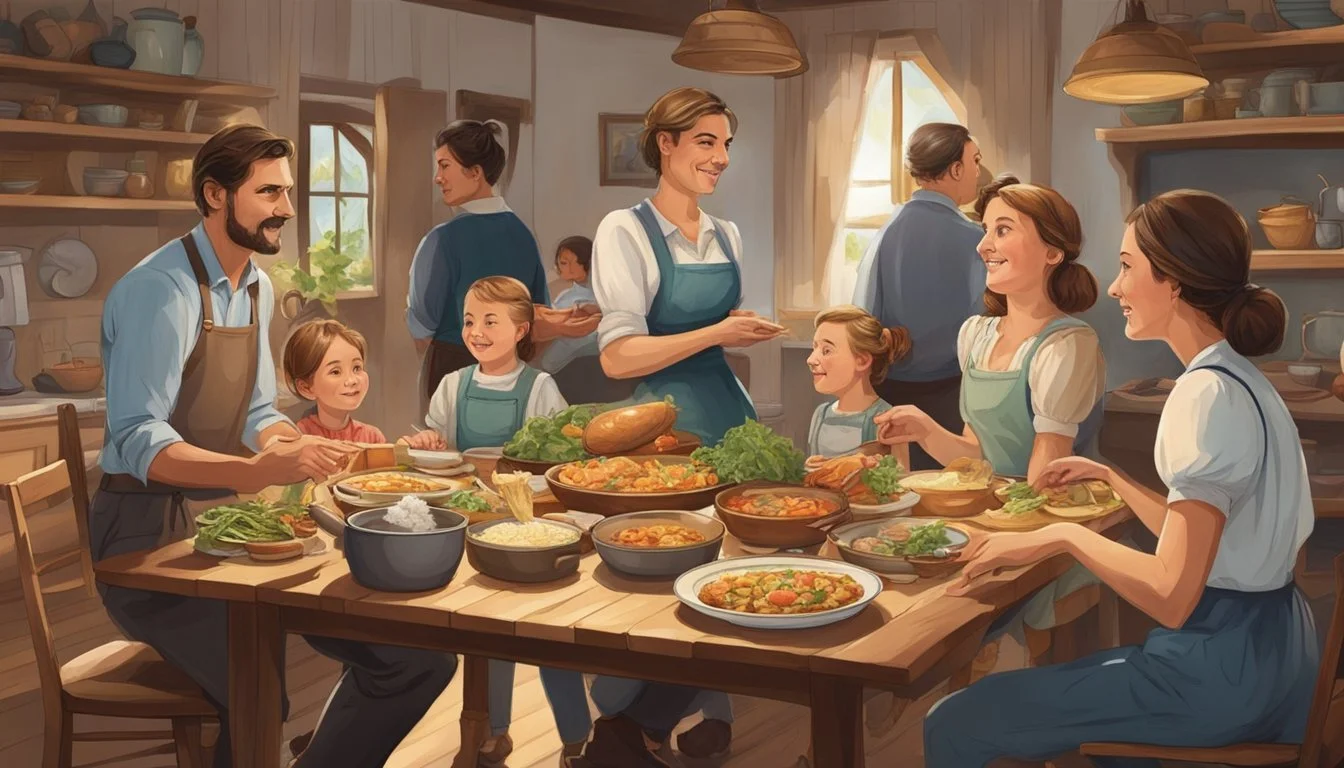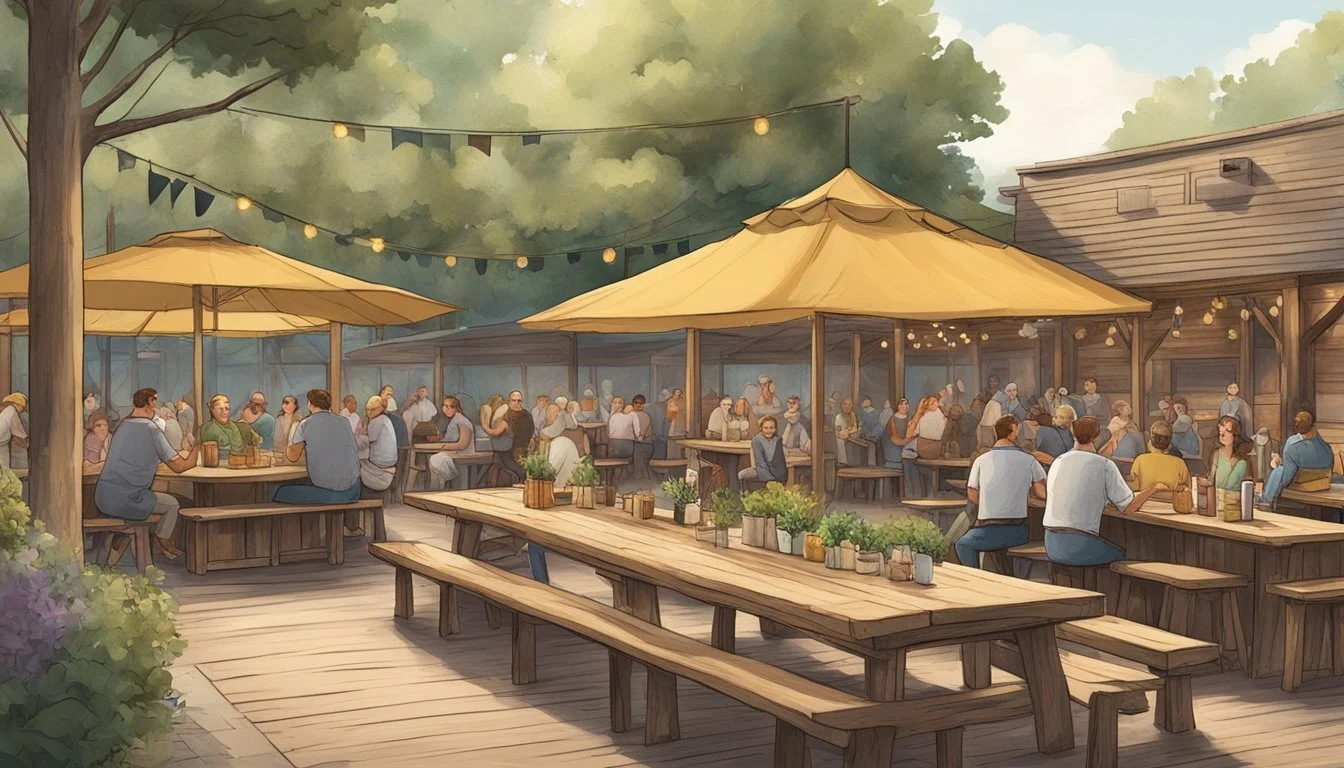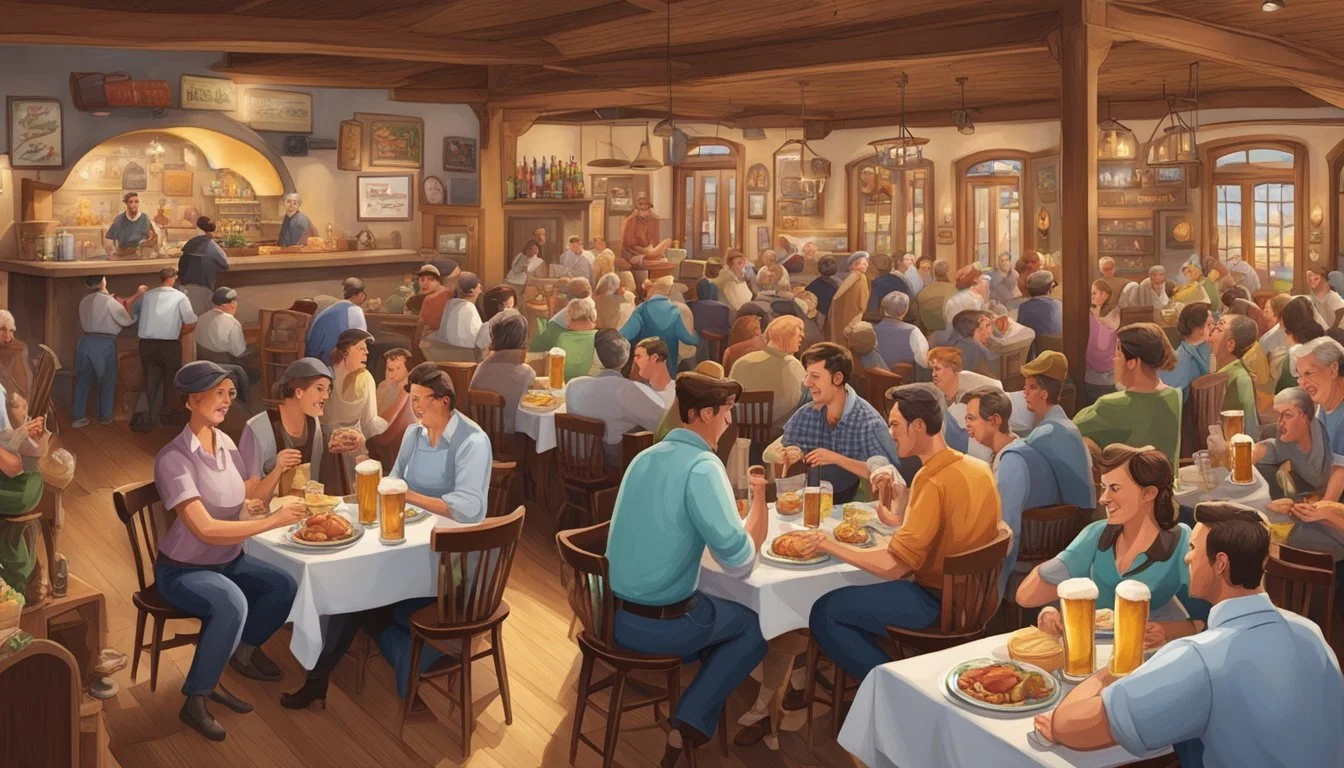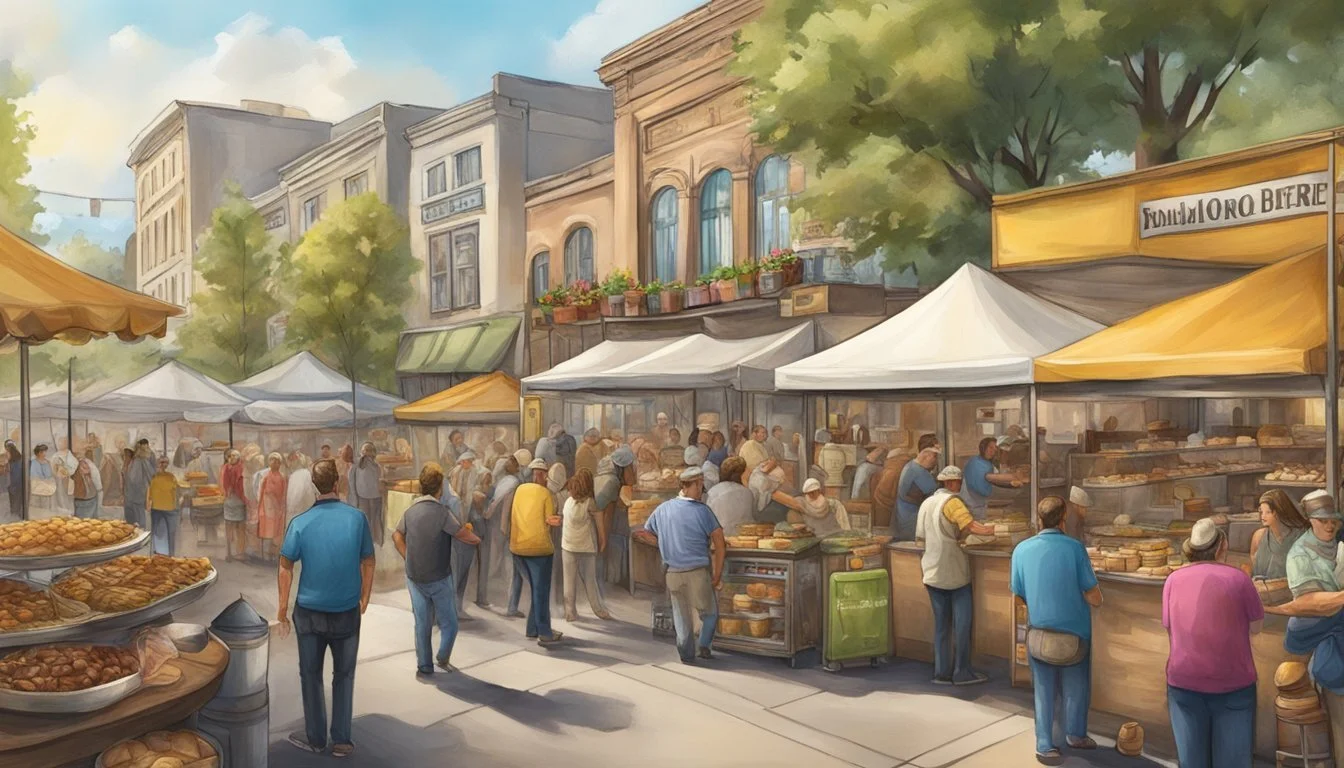German Texan Food and Theater Collaborations
Culinary and Cultural Fusion on Stage
The fusion of German and Texan cultures has produced a rich tapestry of traditions that extend well into the realms of cuisine and theater. As early as the 1830s, German immigrants settled in Texas, bringing with them a culinary heritage that melded with local Texan fare. This blending of tastes led to a unique food culture that found expression not only on dinner plates but also within the vibrant community events and entertainment spaces, including theaters. With dishes like sausages becoming staples at local festivals and events, food has played a central role in these cultural gatherings.
In Texas, the confluence of German and Texan food has been celebrated in various ways, one of which is through community festivals. One such event, Wurstfest in New Braunfels, exemplifies the integration of culture and cuisine, drawing thousands to partake in German-Texan fare while engaging with traditional and contemporary theater productions. These festivals are often significant to the industry, attracting visitors from across the state and beyond, contributing to the local economy and the perpetuation of this unique cultural synthesis.
Tapping into these German Texan food and theater collaborations, local communities have cultivated spaces for cultural exchange. Performances ranging from stage plays to musical acts often feature German Texan themes. The partnerships between local culinary artisans and theater groups provide a platform for both industries to thrive, while also allowing for the preservation and celebration of this distinctive heritage. In these gatherings, one can truly witness the interplay of German precision and Texan flair, harmonized in a celebration that is as palatable as it is performative.
Historical Overview
This section delves into the significant influence of German settlers on Texan food and theater, outlining the trajectory from early settlements to the impact of world conflicts on these cultural collaborations.
Early Settlements and Immigration
German immigrants began arriving in Texas during the early 19th century, significantly under the auspices of the Adelsverein, also known as the Society for the Protection of German Immigrants in Texas. Their settlements proliferated, particularly in Central Texas, bringing with them a rich culinary and theatrical heritage.
Key Immigration Waves:
1840s: Major influx due to economic and political factors in Germany.
Mid-1800s: Steady growth in German immigrant populations, leading to establishment of numerous German-speaking communities.
Cultural Integration and Identity
As immigrants established themselves, German culture profoundly influenced Texan society, seen vividly in the culinary and theatrical arenas. They preserved their identity while integrating into the broader Texan culture, leading to a unique fusion that still persists today.
Cultural Highlights:
Food: Introduction of German culinary traditions, such as sausage-making, evident in events like New Braunfels' Wurstfest.
Theater: German theater thrived in the 19th century, with various productions reflecting cultural narratives and values.
World War Influences
During both World War I and World War II, the identity and cultural expression of German Texans, including food and theater, underwent scrutiny and transformation due to the anti-German sentiment. Nevertheless, post-war periods saw a resurgence in the celebration of German heritage.
World War Impacts:
WWI and WWII: Pressures on German Texans to assimilate and downplay their heritage.
Post-War: Reclamation and revitalization of cultural pride and public events, yet with a nuanced hybrid identity.
Culinary Traditions
The intersection of German and Texan cuisines offers a distinct flavor profile, incorporating traditional ingredients and recipes while embracing celebratory festival foods and unique Tex-Mex adaptations.
Traditional Dishes and Ingredients
German Texan cuisine emphasizes hearty meats and robust flavors. Staple dishes often include:
Sausages: Such as bratwurst and knackwurst, crafted with a combination of pork, beef, or veal.
Sauerkraut: Fermented cabbage, a classic German side dish.
Potatoes: Prepared in various forms, from mashed potatoes to potato salad.
Breads: Dense, hearty rye and pumpernickel loaves.
These ingredients highlight the German heritage, manifesting in foods that have become central to the German Texan table.
Celebration and Festival Foods
Festivals showcase the German influence on Texan cuisine with specific foods:
Oktoberfest: Celebrated with a wide selection of beers, roast meats, and pretzels.
Wurstfest: A New Braunfels tradition serving various sausages, beers, and German delicacies.
Such events highlight the communal aspect of dining, where food serves as a cultural connector.
Tex-Mex Fusion and Adaptation
The fusion of German and Texan cuisines is evident in Tex-Mex dishes, which incorporate German elements:
Nopales: Cactus paddles often found in Tex-Mex dishes, infusing a unique flavor.
Chili con carne: Some variations include German sausages in place of traditional meats.
This adaptation signifies the melding of cultures, creating a unique dining experience through the blend of flavors.
Community and Society
The German influence on Texan society is deeply rooted in the fabric of certain communities, particularly those in the Texas Hill Country such as Fredericksburg and New Braunfels. These towns are bastions of German heritage, showcasing a unique blend of cultural traditions that persist in societal structures, organizations, and educational practices.
Towns and Societal Structures
In the heart of the Texas Hill Country, towns like Fredericksburg and New Braunfels serve as living museums of German cultural influence. The societal structures in these towns were shaped by German settlers in the mid-19th century, creating a distinctive blend of German customs and Texan values. Both towns show their pride with well-preserved architecture and community events that celebrate their rich heritage.
Fredericksburg: Founded by German immigrants in 1846, it maintains its German traditions through community events and local businesses.
New Braunfels: Noted for its German-founded events like Wurstfest, a festival that attracts over 100,000 visitors annually to celebrate German food and traditions.
German Heritage Organizations
The German-Texan Heritage Society plays a pivotal role in fostering German culture within Texan society. This organization aims to preserve, promote, and educate people about the German heritage in Texas. Through their efforts, events like Oktoberfest and Karneval are celebrated, bringing together elements of theatre, authentic German cuisine (What Wine Pairs Perfectly With German Cuisine), and storytelling to maintain a strong sense of community and belonging.
German Free School: Founded in 1857, it was the first chartered school in Austin and is a testament to the prioritization of language and education within German communities.
Language and Education
Language serves as a crucial element in preserving German heritage in Texas. Towns like Fredericksburg still see a use of the German language, although it has waned over the years. Educational institutions, influenced by German settlers, consider bilingual education a fundamental aspect, teaching both English and German to honor their roots.
Boerne: Established by German colonists, where the influence on educational practices can be traced back to the settlers' emphasis on learning and community collaboration.
German language courses:
Elementary: Available in select schools as part of the core curriculum.
Adult Education: Community classes aimed at preservation of heritage and culture.
Arts and Entertainment
The fusion of German-Texan culture manifests vividly in the region's arts and entertainment, with special emphasis on theater, music, and dance that both preserve and celebrate the unique amalgamation of these traditions.
Theater and Performance Arts
German-Texan theater thrives on a rich legacy, often showcasing plays that reflect the bilateral heritage. Festivals like Wurstfest incorporate comedic skits and historical reenactments, illuminating pieces of German-Texan history through performance. These events provide platforms for local artists to infuse German folklore with Texan narratives, fostering a distinctive genre of theater in the Lone Star State.
Music and Dance Events
Saengerfest and other music festivals are cornerstones of the German-Texan artistic community. These events not only feature classical and contemporary German music but also integrate Texan musical styles, creating a unique soundscape. Equally important are dance events where polkas and waltzes meet western swing, symbolizing a harmonious blend of cultures. It is not uncommon to encounter dance troupes at these gatherings, dressed in traditional attire, leading attendees in authentic German-Texan dance, thus preserving the heritage and keeping the community spirit alive.
Food and Beverage Industry
In the midst of a rich cultural tapestry, the food and beverage industry plays a pivotal role in shaping the German Texan culinary scene. With a focus on vibrant breweries and beer culture alongside an evolving dining experience, this section will explore the pivotal entities within these realms.
Breweries and Beer Culture
German Texan culture boasts a strong tradition in breweries, with Scholz Garten standing as a historic landmark in the heart of Texas. This establishment not only serves as a brewery but also as a communal hub, reflecting the region's deep appreciation for craft beers. Brewing stands as a cornerstone of the German Texan identity, with local microbreweries and larger operations alike contributing a diverse array of beers that honor German brewing traditions while inviting innovation.
Notable Breweries in German Texan Culture:
Scholz Garten
Local Craft Breweries
Heritage Beer Establishments
Restaurants and Dining Experience
The dining scene is intrinsically linked to the fusion of German and Texan flavors, offering an experience that is at once traditional and contemporary. Dining establishments often infuse their menus with a blend of local ingredients and German culinary staples, providing patrons with a unique gastronomical journey. Amidst the food offerings, beers from local breweries are commonly featured, enhancing the dining experience and complementing the diverse flavors found on the plate.
Key Elements of Dining in German Texan Culture:
Blended German-Texan Menus
Focus on Locally Sourced Ingredients
Collaboration with Local Breweries
Economic Impact
The German-Texan legacy has significantly influenced the economic landscape of Texas, particularly through advancements in agriculture, ranching, and business. The integration of German culinary traditions and theatrical culture contributed to the development and diversification of local industries.
Agriculture and Ranching
German settlers expertly combined their traditional agricultural practices with Texan resources. A notable example is their success in the production of smoked sausages, which became not only a staple in Texan cuisine but also a viable economic product. In ranching, the cattle industry saw innovative smoking and curing techniques thanks to German influences, adding value to local meats and broadening the market.
Industry Impact:
Introduction of smoked sausages into the market
Enhanced meat preservation techniques from Europe adapted to Texan ranching
Business and Trade Development
The role of German immigrants extended into broader spheres of economic activity in Texas. They facilitated the growth of local businesses by incorporating European influences into the Texan economy. Theatrical productions with German roots, for example, grew from entertainment to cultural institutions, stimulating local economic growth and fostering trade development. Germans in Texas also played pivotal roles in political and civic life, impacting social and economic policies that govern trade and business operations within the state.
Trade Enrichment:
Expansion of businesses through cultural influences in entertainment
Influence on regulations and policies affecting the economic framework of Texas
Cultural Preservation
The preservation of German-Texan culture is evident in the region's architecture and public festivities, reflecting a deep respect for heritage and history.
Architecture and Town Planning
German-Texan communities have historically placed a high value on architecture, particularly in the style known as Fachwerk, a traditional German timber-framing building technique. This method is not only aesthetically distinctive but also represents the skill and ingenuity brought by German immigrants. Town planning in regions like Fredericksburg and New Braunfels displays an emphasis on central squares and communal spaces, reminiscent of German villages.
Notable Examples of Fachwerk Architecture:
Saengerbund Halls
Heritage houses in historic districts
German-influenced public buildings
The Saengerrunde Hall in Austin is a prime example of a space that has preserved German architectural decor and serves as a cultural hub for German-Texan gatherings.
Festivals and Commemorative Events
German-Texan cultural preservation thrives through various festivals and events:
Wurstfest in New Braunfels: Attracts over 100,000 visitors to celebrate German cuisine and beer.
Annual Commemorative Events: Emphasize historical milestones, such as the founding of New Braunfels, and honor cultural figures.
The role of festivals is crucial; they serve as living exhibitions of German-Texan heritage, often highlighting traditional foods and entertainment forms tied to the community's roots.
Influence and Integration
The tapestry of food and theater in Texas is deeply enriched by German influence and its interweaving with diverse cultural elements. This section explores the pivotal role of German, Czech, and other cultural influences in shaping Texan cuisine and theater, and illustrates how these elements have integrated with the Texan cultural identity, creating a blend that is unique to the region.
German and Other Cultural Influences
German cuisine has had a significant impact on Texan food, particularly through sausage-making traditions brought by German immigrants. These practices have become a staple in Texas, leading to a wide variety of sausages enjoyed across the state. The introduction of pastries and baked goods from German and Czech origins further diversified Texan culinary offerings. Czech influence, tied to the larger context of Central European heritage, also contributed to the Texan food scene.
The influence extended into theater and performance, where German dramatic elements often fused with local Texas stories, creating a unique genre of entertainment. German community halls frequently hosted plays and musical performances, blending their cultural traits with Texan motifs.
Integration with Texan Culture
Cultural integration has been exemplified through the evolution of Tex-Mex cuisine, a fusion between Mexican staples and Texan ranching culture, now further enriched by German and Czech flavors. This blend highlights the presence of Germanic techniques in meat preparation and cooking styles within Texan cuisine, often seen alongside Mexican ingredients and spices.
Festivals such as Wurstfest celebrate this fusion, recognizing the enduring culinary and cultural legacy of the German community in Texas. German theater, music, and dance have meshed with Texan festivities, reinforcing a shared cultural identity. Cities like New Braunfels and Fredericksburg serve as cultural hotspots where the integration of German heritage with Texan culture is particularly prominent, preserving a distinctive legacy while promoting continual cultural exchange.









